Broadgay?: An Examination Of Queer Representation in Musicals
"It seems Broadway has never been broader, not because it is all of a sudden societally okay for straight people to consume now, but rather, because queer characters like Alison, Angel, and Hedwig are finally gaining some time in the limelight." -Rose Gelfand
One of my favorite award show openings of all time is Neil Patrick Harris’ number at the 2011 Tony Awards. The whole premise of the song can be distilled to the last line of the first verse, in which Harris enthusiastically proclaims that, “Broadway has never been broader, it’s not just for gays anymore!” For the rest of the song Patrick Harris continues to poke fun at the idea that musical theater, and specifically Broadway, is something exclusively for gay men. He’s held up by sailors wiggling their butts at the audience, elicits testimonies from straight celebrities attending the event, and finally, rips off his black tuxedo with an effeminate shrug to reveal a purple jacket, purple pants and a yellow ascot.
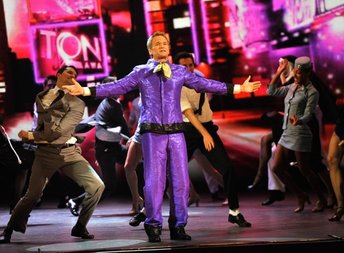
Neil Patrick Harris at the 2011 Tony Awards.
On January 27th, Oakland School for the Arts took its students to go see Fun Home at the Curran theater. All I knew of the show before I saw it (if you don’t want spoilers, skip to the next sentence) was that the main character was a lesbian named Allison, whose father was secretly gay and eventually takes his own life. By the end, however, I was weeping. Not only was it beautifully written and performed, but it was the first time I had recognized my queerness in a character’s experience on stage. I began to wonder, how could this be a first? If Broadway is so commonly thought of as a “gay thing”, where are all the LGBTQ+ characters?
Fun Home has been widely praised for having the first lesbian main character in a Broadway musical, but this is actually incorrect. In 1926, a musical called The Captive premiered at the Empire Theater. It told the story of a woman named Irene, who is in love with a woman named Madame d'Aiguines, as she struggles to live within the constraints of a society that condemns her. It ran for 160 performances, until it was raided and shut down by the New York City police for its portrayal of lesbianism. One of the actors, Basil Rathbone wrote in his autobiography, “As we walked out onto the stage to await our first entrances we were stopped by a plainclothes policeman who showed his badge and said, ‘Please don’t let it disturb your performance tonight but consider yourself under arrest!’”
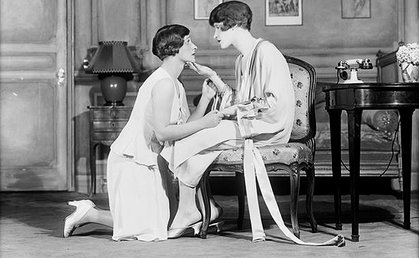
The Captive, 1926.
The next openly gay character would not appear on Broadway for another 43 years. This was Sebastian Baye in Coco, which premiered in 1969—the same year of the Stonewall Riots. Sebastian Baye was a hateful caricature of a gay man, but gay he was nonetheless. A year later, Applause premiered with a character named Duane, a hairdresser who was the first likable, openly gay character. The show also included a scene in a gay bar. In 1973, Seesaw premiered, and in 1974 A Chorus Line was the first major Broadway musical to have gay characters discuss the sexual aspect of their lives, whereas previously gay characters were restricted to the stereotypical personality traits of gayness.
On February 9th, I had the wonderful opportunity to see the 20th Anniversary Tour of Rent at the Golden Gate Theater. I was invited to attend a Q&A with members of the cast and crew of Rent, through the Q Center at the Jewish Community Center of San Francisco. I wanted to pick their brains on queer representation in musicals and I began by asking, “Obviously Rent was a revolutionary piece of art about queerness in its time, and revolutionized the way queer representation existed. Here we are, 20 years later. What do you think has changed about queer representation since Rent first premiered and what has stayed the same?¨
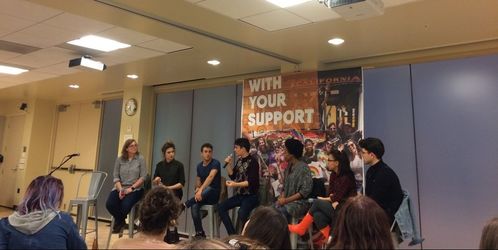
The Rent Cast at JCCSF, 2/9/17.
Their answers were fascinating. Danny Harris Kornfeld, who plays Mark, responded, “I think, now that we know that we are here. People know that the LGBTQ community exists, it’s different stories now. It’s not just like, we are here. But it’s the whole range. We have origin stories about growing up, and it's the different stories of people in the community, not just the story about being a part of it.”
David Merino, who plays Angel in the production added, “normalizing [queerness] since
Rent
has been a huge difference, for sure. Angel used to stand out as like, ¨Who is that, girl!???¨ and now there are so many people like her, and the increased visibility since Rent has paved the idea that it’s not bad to show it.”
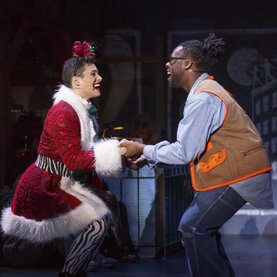
David Merino as Angel and Aaron Harrington as Collins in the 20th Anniversary Tour of Rent
Michael McClure, who is a swing for Mark and the dance captain, chimed in, “I think one of the things I see, is in Rent they’re certainly dealing with the sexual nature of the relationship, and that element is there, but it was kind of the first time that it was just seeing any of these characters in a moment in their lives, and exploring love and finding it.”
What was almost more interesting than their thoughts on the way representation has changed, were the stories they told of how queer representation has affected them in their own journey of identity.
In answering the question of how each cast member first heard of Rent, Merino spoke about a time when he was sick and somehow ended up with a copy of the Rent movie.
He said that Angel, “was the first time I’d seen a gay character who wasn’t laughed at.
The only characters I’d seen who were gay were super overly flamboyant on shows like The Simpsons, and my family would always laugh at them because they were funny.
But Angel was the first time that I could see myself in a character like that.
And every night, going on I want to cry, because Angel is all I wanted to be as a kid.”
The production’s stage manager, Jane Davis, shared a similar story about Fun Home, “My mom is extremely supportive of me as a queer woman, and I took her to see Fun Home and Allison is a character I really relate to.
Afterward, it felt weird.
She asked me, ‘Is that how you felt growing up?’ and I just started crying because I was like ‘YES’ and that was my recognition and it was really profound.”
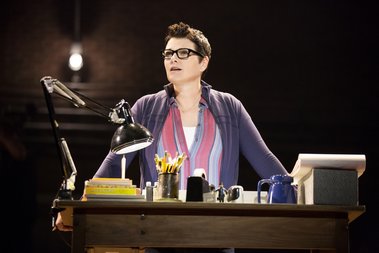
Kate Shindle as Allison in the national tour of Fun Home.
As I continued to research the history of LGBTQ+ representation in Broadway musicals, I became increasingly frustrated with the lack of statistics and data.
It seemed, to me, that no one had ever mapped out queer representation empirically, and so I attempted to do so.
(A note about my data: bear in mind, these numbers are estimates, as I was piecing together data with limited time and available resources. I counted musicals with characters who fit in multiple categories [for example, Rent having lesbian, bi and gay characters] in each category they have a character in. I counted each show that I could find, with characters that have been explicitly named as, or culturally understood as being that identity, regardless of how big of a role or how positive/negative the portrayal is.)
According to my research, there have been at least 591 musicals on Broadway since the first Broadway musical, The Elves in the mid 1800s.
Of those 591 musicals, I could find approximately:
- 20 with gay men characters
- 7 with lesbians
- 2 with bisexual characters: one man (Lucas in If/Then) and one woman (Maureen in Rent, though Maureen is never explicitly named as bisexual, but dates Mark and Joane.)
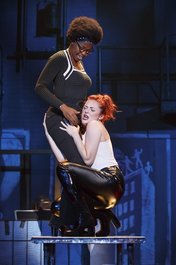
Jasmine Easler and Katie LaMark as Joane and Maureen in the 20th Anniversary Tour of Rent.
It gets a bit trickier when it comes to measuring transgender and gender nonconforming representation.
Because many of these musicals are older, and none of them were written by trans people, the language around characters who don’t fit traditional gender expectations and/or aren’t cis gets muddy.
For example, later in the Rent Q&A, Davis said:
“Rent, though still relevant, is dated. It was written by a straight, white, cisgender man. So how he spoke about things are dated today, and perhaps were even slightly incorrect, with how he wrote them. We were talking about the character of Angel, how he’s referred to as a drag queen and a transsexual, and today we look at Angel and we’re just like, he’s fluid. And that’s who he or she is.”
This is similar to the confusion over the gender of Frankenfurter in Rocky Horror, and Hedwig in Hedwig and the Angry Inch. Though Hedwig is often considered to be a trans woman, John Cameron Mitchell who wrote the show has explained that Hedwig is actually genderqueer, saying "she's more than a woman or a man."
Furthermore, musicals like Kinky Boots, where the main character is a straight man who is a drag queen, get thrown in with Rocky Horror, Hedwig and the like, because traditionally, the main roles in all of them are played by cisgender gay men.
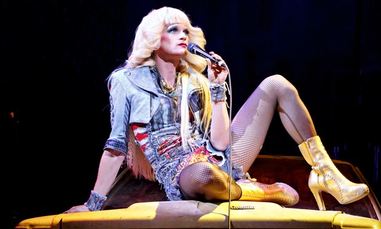
Neil Patrick Harris, a cisgender gay man, playing Hedwig in Hedwig and the Angry Inch.
When it all comes down to it, there are LGBTQ+ characters in (approximately) slightly less than 5% of all Broadway musicals. It seems Broadway has never been broader, not because it is all of a sudden societally okay for straight people to consume now, but rather, because queer characters like Alison, Angel, and Hedwig are finally gaining some time in the limelight.
“That’s why queer people need to write these stories, ‘cause it can be so powerful and it can mean so much to you, Davis added. This sentiment was echoed throughout the night by multiple cast members. These stories are important to the way queer people are viewed, and the way we view ourselves. Yes, let’s celebrate the small but rich history of LGBTQ+ characters, but let us look towards a future where gay people get as much out of Broadway as they put in, and are given the platform to tell their own stories.





0 General Document comments
0 Sentence and Paragraph comments
0 Image and Video comments
New Conversation
General Document Comments 0

